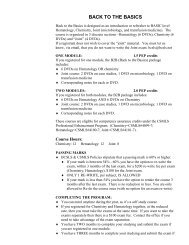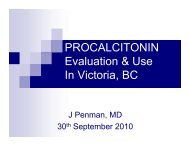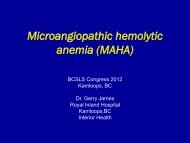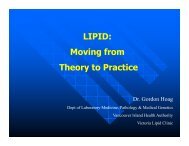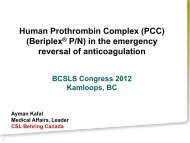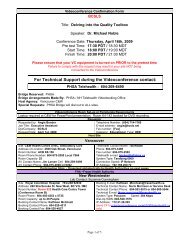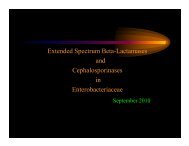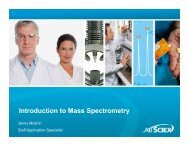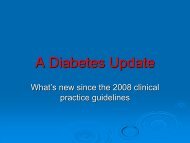Medical Laboratory Assistant - the British Columbia Society of ...
Medical Laboratory Assistant - the British Columbia Society of ...
Medical Laboratory Assistant - the British Columbia Society of ...
You also want an ePaper? Increase the reach of your titles
YUMPU automatically turns print PDFs into web optimized ePapers that Google loves.
COMPETENCY GUIDELINES<br />
_______________________________________________<br />
<strong>Medical</strong> <strong>Laboratory</strong><br />
<strong>Assistant</strong><br />
Competencies Expected <strong>of</strong> an entry-level <strong>Medical</strong><br />
<strong>Laboratory</strong> <strong>Assistant</strong><br />
February 2011<br />
<strong>British</strong> <strong>Columbia</strong> <strong>Society</strong> <strong>of</strong> <strong>Laboratory</strong> Science<br />
#720 – 999 West Broadway, Vancouver, BC V5Z 1K5<br />
www.bcsls.net bcsls@bcsls.net Phone (604) 714-1760 fax (604) 738-4080
BCSLS COMPETENCIES<br />
FOR CERTIFICATION OF MEDICAL<br />
LABORATORY ASSISTANTS<br />
This document describes <strong>the</strong> minimum level <strong>of</strong> knowledge<br />
and skills required for <strong>the</strong> certification <strong>of</strong> a <strong>Medical</strong> <strong>Laboratory</strong><br />
<strong>Assistant</strong>.<br />
©<br />
Approved by <strong>the</strong> Board <strong>of</strong> Directors on: Feb 8, 2011<br />
The BCSLS would like to acknowledge and thank <strong>the</strong> CSMLS and<br />
OSMT for allowing us to use excerpts from <strong>the</strong>ir MLA Competency<br />
Guidelines in <strong>the</strong> formulation <strong>of</strong> <strong>the</strong>se guidelines for <strong>British</strong> <strong>Columbia</strong>.<br />
This ensures that <strong>the</strong> guidelines are national in scope and contribute<br />
to <strong>the</strong> portability <strong>of</strong> skills and <strong>the</strong> mobility <strong>of</strong> <strong>the</strong> MLA workforce.<br />
BCSLS MLA Competency Guidelines 2
Code <strong>of</strong> Pr<strong>of</strong>essional Conduct<br />
<strong>Medical</strong> laboratory pr<strong>of</strong>essionals are dedicated to serving <strong>the</strong> health care needs<br />
<strong>of</strong> <strong>the</strong> public. The welfare <strong>of</strong> <strong>the</strong> patient and respect for <strong>the</strong> dignity <strong>of</strong> <strong>the</strong><br />
individual shall be paramount at all times.<br />
<strong>Medical</strong> laboratory pr<strong>of</strong>essionals work with o<strong>the</strong>r health care pr<strong>of</strong>essionals, to<br />
provide effective patient care.<br />
<strong>Medical</strong> laboratory pr<strong>of</strong>essionals shall promote <strong>the</strong> image and <strong>the</strong> status <strong>of</strong> <strong>the</strong>ir<br />
pr<strong>of</strong>ession by maintaining high standards in <strong>the</strong>ir pr<strong>of</strong>essional practice and<br />
through active support <strong>of</strong> <strong>the</strong>ir pr<strong>of</strong>essional bodies.<br />
<strong>Medical</strong> laboratory pr<strong>of</strong>essionals shall protect <strong>the</strong> confidentiality <strong>of</strong> all patient<br />
information.<br />
<strong>Medical</strong> laboratory pr<strong>of</strong>essionals shall take responsibility for <strong>the</strong> pr<strong>of</strong>essional<br />
acts.<br />
<strong>Medical</strong> laboratory pr<strong>of</strong>essionals shall practice within <strong>the</strong> scope <strong>of</strong> <strong>the</strong>ir<br />
pr<strong>of</strong>essional competence.<br />
<strong>Medical</strong> laboratory pr<strong>of</strong>essionals shall endeavour to maintain and improve <strong>the</strong>ir<br />
skills and knowledge and keep current with scientific advances.<br />
<strong>Medical</strong> laboratory pr<strong>of</strong>essionals shall share <strong>the</strong>ir knowledge with colleagues and<br />
promote learning.<br />
<strong>Medical</strong> laboratory pr<strong>of</strong>essionals shall be aware <strong>of</strong> <strong>the</strong> laws and regulations<br />
governing <strong>Medical</strong> laboratory technology and shall apply <strong>the</strong>m in <strong>the</strong> practise <strong>of</strong><br />
<strong>the</strong>ir pr<strong>of</strong>ession.<br />
<strong>Medical</strong> laboratory pr<strong>of</strong>essionals shall practise safe work procedures at all times<br />
to ensure <strong>the</strong> safety <strong>of</strong> patients and coworkers and <strong>the</strong> protection <strong>of</strong> <strong>the</strong><br />
environment.<br />
**Adopted from <strong>the</strong> CSMLS Code <strong>of</strong> Conduct --with permission 2006<br />
BCSLS MLA Competency Guidelines 3
UNIT 1<br />
A. Role <strong>of</strong> <strong>Medical</strong> <strong>Laboratory</strong> <strong>Assistant</strong>s<br />
B. Pr<strong>of</strong>essionalism<br />
C. Legal and Ethical<br />
D. Communication<br />
E. Quality Management and Improvement<br />
__________________________________<br />
A: ROLE OF MEDICAL LABORATORY ASSISTANT<br />
The <strong>Medical</strong> <strong>Laboratory</strong> <strong>Assistant</strong> is an integral member <strong>of</strong> <strong>the</strong> health care team<br />
who shares knowledge, promotes learning, and collaborates with o<strong>the</strong>r<br />
pr<strong>of</strong>essionals in providing effective patient care.<br />
COMPETENCIES:<br />
Perform <strong>the</strong> required duties within <strong>the</strong> scope <strong>of</strong> practice <strong>of</strong> <strong>the</strong> <strong>Medical</strong> <strong>Laboratory</strong> <strong>Assistant</strong><br />
in <strong>the</strong> hospital laboratory system; community laboratories; public health laboratories and<br />
private laboratories<br />
Knowledgeable in <strong>the</strong> <strong>the</strong>ory, technical skills and clinical application <strong>of</strong> procedures performed<br />
in <strong>the</strong> laboratory<br />
Understand <strong>the</strong> importance <strong>of</strong> <strong>the</strong> skill <strong>of</strong> <strong>the</strong> <strong>Medical</strong> <strong>Laboratory</strong> <strong>Assistant</strong> in relation to<br />
patient care; specimen procurement and specimen integrity<br />
Participate in providing for <strong>the</strong> health care needs <strong>of</strong> <strong>the</strong> public, keeping <strong>the</strong> welfare<br />
and confidentiality <strong>of</strong> <strong>the</strong> patient paramount at all times, and respecting <strong>the</strong> dignity,<br />
values, privacy and beliefs <strong>of</strong> <strong>the</strong> individual.<br />
Remain current in worksite policies and guidelines and MSP regulations and protocols<br />
Participate in continuous learning by attending internal and external education opportunities<br />
BCSLS MLA Competency Guidelines 4
B: PROFESSIONALISM<br />
The <strong>Medical</strong> <strong>Laboratory</strong> <strong>Assistant</strong> is responsible and accountable for his/her<br />
pr<strong>of</strong>essional actions and practices according to standards <strong>of</strong> practice as well as<br />
laws and regulations governing <strong>the</strong> pr<strong>of</strong>ession.<br />
COMPETENCIES:<br />
Understand and discuss <strong>the</strong> components <strong>of</strong> pr<strong>of</strong>essionalism<br />
Accountability<br />
Responsibility<br />
Communication<br />
Motivation and attitude<br />
Safety<br />
Competence<br />
Continuing Education<br />
Promote <strong>the</strong> image and status <strong>of</strong> <strong>the</strong> pr<strong>of</strong>ession <strong>of</strong> medical laboratory science as a<br />
member <strong>of</strong> <strong>the</strong> health care team by maintaining established standards <strong>of</strong> practice; dress<br />
code, personal hygiene, and appearance.<br />
C: LEGAL AND ETHICAL ISSUES<br />
The <strong>Medical</strong> <strong>Laboratory</strong> <strong>Assistant</strong> complies with legislation governing medical<br />
laboratory science and applies <strong>the</strong> legislation to <strong>the</strong> practice <strong>of</strong> <strong>the</strong> pr<strong>of</strong>ession.<br />
COMPETENCIES:<br />
Define, understand and practice <strong>the</strong> principles <strong>of</strong> Confidentiality<br />
Define legal and ethical terms and discuss how <strong>the</strong>se terms apply to <strong>the</strong> scope <strong>of</strong> practice for<br />
<strong>the</strong> <strong>Medical</strong> <strong>Laboratory</strong> <strong>Assistant</strong><br />
Assault and Battery<br />
Duty <strong>of</strong> Care<br />
Competence<br />
Liability<br />
Negligence<br />
Consent<br />
Patient Rights<br />
Patients Rights to refuse<br />
Employees Rights to refuse<br />
Knowledge <strong>of</strong>:<br />
Personal Health Information Protection and Electronic Documents Act(PIPEDA),<br />
Chain <strong>of</strong> Custody documentation<br />
FOI – Freedom <strong>of</strong> Information<br />
BCSLS MLA Competency Guidelines 5
D: INTERPERSONAL COMMUNICATION<br />
The <strong>Medical</strong> <strong>Laboratory</strong> <strong>Assistant</strong> interacts in a pr<strong>of</strong>essional and competent<br />
manner, using effective listening, verbal and written communications in dealing<br />
with laboratory colleagues, patients, students, clients, and o<strong>the</strong>r health<br />
pr<strong>of</strong>essionals.<br />
COMPETENCIES:<br />
Write and speak clearly and concisely<br />
Work effectively as a team member and is aware <strong>of</strong> response to o<strong>the</strong>rs - feedback, listening<br />
skills, verbal and non verbal communication<br />
Respond to negative effects <strong>of</strong> ineffective and confrontational communication approaches<br />
Understand factors that may influence effective communication: Age, physical, mental<br />
condition, Stress levels, fear, etc.<br />
Understand <strong>the</strong> effectiveness <strong>of</strong> time management and establishing priorities<br />
Demonstrate <strong>the</strong> characteristics and qualities <strong>of</strong> caring: respect; courtesy, empathy, and<br />
warmth<br />
BCSLS MLA Competency Guidelines 6
E: QUALITY MANAGEMENT<br />
The <strong>Medical</strong> <strong>Laboratory</strong> <strong>Assistant</strong> understands <strong>the</strong> importance <strong>of</strong> Quality Management<br />
and Quality Assurance in performance <strong>of</strong> Standing Operating Procedures and in<br />
specimen integrity<br />
COMPETENCIES:<br />
Follow Standard operating procedures and policies within <strong>the</strong> laboratory and specimen<br />
procurement<br />
Understand Quality control measures<br />
Provides feedback on new procedures and workflow<br />
Understand Risk Management<br />
Complete documentation required for temperature recordings<br />
Complete documentation required for equipment maintenance<br />
Complete necessary documentation for critical incidents involving patients or specimen<br />
procurement<br />
Understand and participate in new initiatives such as LEAN/ Six Sigma.<br />
BCSLS MLA Competency Guidelines 7
UNIT 2<br />
A. Anatomy and Physiology<br />
B. <strong>Laboratory</strong> Terminology and Measurement<br />
C. <strong>Laboratory</strong> Safety and Infection Control<br />
__________________________________<br />
A: ANATOMY AND PHYSIOLOGY<br />
The <strong>Medical</strong> <strong>Laboratory</strong> <strong>Assistant</strong> must be able to demonstrate basic knowledge<br />
<strong>of</strong> <strong>the</strong> human body structure and <strong>the</strong> major body systems and functions<br />
COMPETENCIES:<br />
General knowledge <strong>of</strong> <strong>the</strong> following Body Systems:<br />
Integumentary<br />
Musculoskeletal<br />
Circulatory<br />
Urinary<br />
Digestive<br />
Respiratory<br />
Nervous<br />
Reproductive<br />
Endocrine<br />
Lymphatic<br />
Immune<br />
Identify <strong>the</strong> main structures and functions <strong>of</strong> <strong>the</strong> Circulatory system relevant for blood<br />
collection:<br />
Arteries, veins, capillaries<br />
Blood components<br />
Coagulation <strong>the</strong>ory and factors<br />
Knowledge <strong>of</strong> <strong>the</strong> common tests and procedures related to <strong>the</strong> above body systems.<br />
BCSLS MLA Competency Guidelines 8
B: LABORATORY TERMINOLOGY AND MEASUREMENT<br />
The <strong>Medical</strong> <strong>Laboratory</strong> <strong>Assistant</strong> demonstrates understanding and <strong>the</strong> use <strong>of</strong><br />
correct medical terminology and measurements (basic SI units commonly used in<br />
<strong>the</strong> laboratory and 24-hr clock)<br />
COMPETENCIES:<br />
Define and use correct terminology related to specimen collection<br />
Define terminology commonly used in <strong>the</strong> laboratory<br />
Define terminology related to <strong>the</strong> major body systems and diseases<br />
Understand and define terminology related to <strong>the</strong> measurement systems used in <strong>the</strong><br />
laboratory:<br />
SI Units<br />
Metric System<br />
24 hour clock<br />
C: LABORATORY SAFETY AND INFECTION CONTROL<br />
The <strong>Medical</strong> <strong>Laboratory</strong> <strong>Assistant</strong> conducts pr<strong>of</strong>essional practice according to<br />
established protocols, safety guidelines, and existing legislation and in <strong>the</strong> use <strong>of</strong><br />
safety equipment.<br />
COMPETENCIES: LABORATORY SAFETY:<br />
Knowledge <strong>of</strong> and demonstrate good practice in:<br />
Standard Precautions<br />
Handling and disposal <strong>of</strong> Sharps<br />
Handling and packaging <strong>of</strong> specimens<br />
Utilization <strong>of</strong> <strong>Laboratory</strong> Safety equipment : fume hoods, biological cabinets<br />
Use <strong>of</strong> protective clothing and equipment (PPE) – gloves; gowns, masks, shields,<br />
Knowledge <strong>of</strong> Isolation and Reverse isolation techniques<br />
Knowledge <strong>of</strong> disinfection; decontamination and sterilization <strong>of</strong> laboratory equipment and<br />
premises<br />
Knowledge <strong>of</strong> storage <strong>of</strong> reagents and chemicals within <strong>the</strong> laboratory<br />
Knowledge <strong>of</strong> chemical hazards<br />
BCSLS MLA Competency Guidelines 9
Knowledge <strong>of</strong> electrical safety<br />
Knowledge <strong>of</strong> fire safety and use <strong>of</strong> fire extinguishers<br />
Knowledge <strong>of</strong> use <strong>of</strong> spill kits and containment procedures for biological or chemical hazards<br />
Knowledge <strong>of</strong> radiation hazards<br />
Knowledge <strong>of</strong> legislated Acts and importance <strong>of</strong> documentation and reporting requirements:<br />
MSDS ( Material Safety Data Sheets)<br />
WHMIS<br />
TDG (Transport <strong>of</strong> Dangerous Goods)<br />
Work Safe BC<br />
Blood and Body Fluid and Needle stick protocols<br />
Biohazard specimens<br />
Hazard and Incident reporting<br />
FIT Testing (N95 Mask)<br />
Knowledge <strong>of</strong> Pandemic procedures – SARS; H1N1; Norwalk<br />
Knowledge <strong>of</strong> Legislated packaging and transport :<br />
a. Human except Specimens<br />
b. Category B specimens<br />
c. Category A specimens<br />
COMPETENCIES: INFECTION CONTROL<br />
Knowledge <strong>of</strong> and describe infectious diseases and etiological agents : bacteria, fungi,<br />
viruses, parasites<br />
Have knowledge <strong>of</strong> and describe basic mechanisms <strong>of</strong> disease transmission and host<br />
interaction and prevention<br />
Importance <strong>of</strong> hand washing, good hygiene; disinfection controls<br />
MRSA<br />
Have knowledge <strong>of</strong> transmission and prevention <strong>of</strong> Hep A; B; C<br />
Have knowledge <strong>of</strong> Importance <strong>of</strong> Hep B vaccination<br />
Have knowledge <strong>of</strong> Transmission and prevention <strong>of</strong> HIV<br />
BCSLS MLA Competency Guidelines 10
UNIT 3<br />
A. Patient Identification<br />
B. Specimen Collection by Venipuncture<br />
C. Specimen Collection by Skin Puncture<br />
D. Collection and Handling <strong>of</strong> Urine Specimens<br />
E. Collection and Handling <strong>of</strong> Microbiology<br />
Specimens<br />
F. Specimen Handling and Processing :<br />
Hematology/Chemistry<br />
G. Miscellaneous Specimen Collection and<br />
Processing<br />
H. Pre Analytical Specimen Preparation<br />
__________________________________<br />
A: PATIENT IDENTIFICATION<br />
The <strong>Medical</strong> <strong>Laboratory</strong> <strong>Assistant</strong> verifies relevant data and ensures that<br />
appropriate specimens are procured according to established protocols and<br />
specimen integrity. The medical laboratory assistant verifies accurate patient<br />
identification<br />
COMPETENCIES:<br />
Demonstrates knowledge <strong>of</strong> established protocols for accurate patient identification.<br />
Demonstrates knowledge <strong>of</strong> rules <strong>of</strong> confidentiality in regards to personal patient information<br />
Demonstrates knowledge <strong>of</strong> <strong>the</strong> steps for proper patient and sample identification in all stages <strong>of</strong><br />
data entry; specimen collection and handling to generation <strong>of</strong> report to physician<br />
Demonstrates knowledge <strong>of</strong> <strong>the</strong> protocols for procurement <strong>of</strong> information with legal/industrial<br />
implications and ensures chain <strong>of</strong> custody is maintained, e.g. blood alcohol, urine drug testing;<br />
confidential testing e.g. HIV<br />
BCSLS MLA Competency Guidelines 11
B: SPECIMEN COLLECTION – VENIPUNCTURE<br />
The <strong>Medical</strong> <strong>Laboratory</strong> <strong>Assistant</strong> ensures that appropriate specimens are<br />
procured according to established protocols and specimen integrity. Patient safety<br />
and safe specimen procurement practices are integral to this function.<br />
COMPETENCIES:<br />
Identify and describe location <strong>of</strong> major veins and arteries in arms and hands<br />
Knowledge <strong>of</strong> guidelines in selection <strong>of</strong> appropriate venipuncture site in arms and hands and feet<br />
Knowledge <strong>of</strong> guidelines in selection <strong>of</strong> venipuncture vs skin puncture<br />
Identify and describe <strong>the</strong> types, parts and demonstrate appropriate uses <strong>of</strong> equipment required to<br />
collect specimens by venipuncture:<br />
Vacutainer needles and gauge <strong>of</strong> needle needles including adapters and<br />
holders<br />
Types <strong>of</strong> evacuated tubes and determine additives and <strong>the</strong>ir requirement for<br />
testing procedures<br />
Use and release <strong>of</strong> tourniquets<br />
Antiseptic cleansing solutions; alcohol; iodine<br />
Use <strong>of</strong> butterfly and safe disposal<br />
Use <strong>of</strong> syringe and syringe transfer device<br />
Sharps disposal systems for needles<br />
Demonstrate correct venipuncture technique and established procedures:<br />
Verification and identification <strong>of</strong> patient according to established protocols<br />
Select appropriate sites for venous collection for adults, children and infants<br />
Demonstrate positioning <strong>of</strong> patient for blood collection<br />
Demonstrate correct technique for venipuncture<br />
Demonstrate successful collection <strong>of</strong> blood by venipuncture<br />
NOTE: BCSLS GUIDELINE: STUDENTS MUST DEMONSTRATE SUCCESSFUL<br />
COMPLETION OF A MINIMUM OF 12 VENIPUNCTURES PRIOR TO PRACTICUM<br />
<br />
<br />
<br />
<br />
Demonstrate verification and labeling <strong>of</strong> specimens<br />
Have knowledge <strong>of</strong> importance <strong>of</strong> order <strong>of</strong> draw<br />
Demonstrate correct inversion <strong>of</strong> vacutainer tubes according to guidelines<br />
Demonstrate care after collection<br />
Knowledge <strong>of</strong> appropriate blood volumes for collection<br />
BCSLS MLA Competency Guidelines 12
SPECIMEN COLLECTION CONT’D<br />
Knowledge <strong>of</strong> how to deal with complications associated with venipuncture:<br />
Patients with no identification<br />
Failure to draw blood<br />
Rolling Veins<br />
Sclerosed Veins or scarred veins<br />
Collapsed Veins<br />
Hematoma<br />
Thrombosed area<br />
Endemnitous area<br />
Burned area<br />
Excessive Bleeding<br />
Petechiae<br />
Knowledge <strong>of</strong> how to deal with unusual patient circumstances:<br />
Unconscious<br />
Obesity<br />
Uncooperative<br />
Anxious<br />
Fainting<br />
Seizures<br />
Impaired patient<br />
Abusive patient<br />
Knowledge <strong>of</strong> how to deal with circumstances or collections requiring special care:<br />
Infections<br />
Burns<br />
Diabetic patients<br />
Cancer patients<br />
Dialysis patient – fistulas, shunts<br />
Children and infants<br />
Mastectomy<br />
PIC lines<br />
Arterial lines<br />
IV areas<br />
Knowledge <strong>of</strong> procedures determining specimen integrity:<br />
specimen priority<br />
turn around time<br />
basal state and factors affecting basal state<br />
rationale for rejection <strong>of</strong> specimens<br />
protocols regarding repeat collections<br />
transport and storage <strong>of</strong> specimens<br />
BCSLS MLA Competency Guidelines 13
C: SPECIMEN COLLECTION BY CAPILLARY (MICRO COLLECTION)<br />
The <strong>Medical</strong> <strong>Laboratory</strong> <strong>Assistant</strong> verifies relevant data and ensures that<br />
appropriate specimens are procured according to established protocols for skin<br />
puncture and specimen integrity. The medical laboratory assistant verifies<br />
accurate patient identification<br />
COMPETENCIES:<br />
Knowledge <strong>of</strong> <strong>the</strong> types <strong>of</strong> equipment used to collect skin puncture and demonstrate appropriate<br />
use.<br />
Knowledge <strong>of</strong> use <strong>of</strong> micro collection containers and knowledge <strong>of</strong> min/max levels<br />
Knowledge <strong>of</strong> use <strong>of</strong> cleansing solutions <strong>of</strong> skin as per protocols<br />
Demonstrate correct technique for skin puncture for adults, children, infants and neonates<br />
choice <strong>of</strong> correct equipment for testing<br />
Choice <strong>of</strong> appropriate collection site in finger or heel<br />
Appropriate warming, cleansing <strong>of</strong> site<br />
Knowledge <strong>of</strong> complications and limitations <strong>of</strong> skin puncture collection<br />
Demonstrate care after collection<br />
Knowledge <strong>of</strong> procedures determining specimen integrity:<br />
Standards <strong>of</strong> blood volume collection in infants and neonates<br />
Protocols <strong>of</strong> repeat collections<br />
Knowledge <strong>of</strong> handling and transport <strong>of</strong> specimens<br />
Storage <strong>of</strong> specimens<br />
D: COLLECTION AND PREPARATION OF URINE SPECIMENS<br />
The <strong>Medical</strong> <strong>Laboratory</strong> <strong>Assistant</strong> has <strong>the</strong> knowledge and skills necessary for <strong>the</strong><br />
collection and testing <strong>of</strong> urine specimens and instruction to <strong>the</strong> patient on <strong>the</strong><br />
established procedure in collection <strong>of</strong> <strong>the</strong> specimens<br />
COMPETENCIES:<br />
Knowledge <strong>of</strong> <strong>the</strong> types <strong>of</strong> urinalysis collection containers<br />
BCSLS MLA Competency Guidelines 14
Knowledge <strong>of</strong> and demonstrate <strong>the</strong> ability to provide instructions for <strong>the</strong> common tests for<br />
urinalysis:<br />
routine and microscopic<br />
culture and sensitivity<br />
24 hour urine<br />
Cytology urine<br />
Urine drug screens<br />
Knowledge <strong>of</strong> established instructions for 24 hour urine collections<br />
Knowledge <strong>of</strong> 24 hour urine preservation, preservatives and <strong>the</strong>ir proper use<br />
Demonstrate <strong>the</strong> procedures for measuring total volume <strong>of</strong> 24 hour urine and have knowledge <strong>of</strong><br />
<strong>the</strong> requirement to <strong>the</strong> test requested<br />
Knowledge <strong>of</strong> <strong>the</strong> terminology associated with urinalysis collection procedures:<br />
random<br />
first morning<br />
timed<br />
midstream<br />
clean catch<br />
Knowledge <strong>of</strong> criteria for rejection <strong>of</strong> unacceptable specimens<br />
Demonstrate correct labeling; preparation and storage <strong>of</strong> urine samples according to established<br />
protocols<br />
Knowledge <strong>of</strong> <strong>the</strong> preparation <strong>of</strong> urine for microscopic examination<br />
Have knowledge <strong>of</strong> requirements and preparation <strong>of</strong> urine collection for Cytology<br />
Knowledge <strong>of</strong> requirements and documentation for testing for urine drug screens<br />
knowledge <strong>of</strong> non legal testing requirements and protocols<br />
knowledge <strong>of</strong> legal testing requirements and protocols<br />
knowledge <strong>of</strong> chain <strong>of</strong> custody procedures<br />
BCSLS MLA Competency Guidelines 15
E: COLLECTION AND PREPARATION OF MICROBIOLOGY SPECIMENS<br />
The <strong>Medical</strong> <strong>Laboratory</strong> <strong>Assistant</strong> has <strong>the</strong> knowledge and skills necessary for<br />
<strong>the</strong> collection <strong>of</strong> microbiology specimens and instruction to <strong>the</strong> patient on<br />
established procedure in collection <strong>of</strong> <strong>the</strong> specimens.<br />
COMPETENCIES:<br />
Knowledge <strong>of</strong> <strong>the</strong> principles <strong>of</strong> blood culture collection; distinguish between aerobic; anaerobic<br />
Demonstrate collection and labeling <strong>of</strong> blood culture specimens according to required protocols<br />
Knowledge <strong>of</strong> appropriate containers and specimen collection requirements <strong>of</strong> common<br />
microbiology tests<br />
Knowledge <strong>of</strong> and demonstrate <strong>the</strong> ability to instruct <strong>the</strong> patient in <strong>the</strong> collection <strong>of</strong> common<br />
microbiology tests:<br />
Demonstrate correct labeling <strong>of</strong> specimens for testing<br />
Knowledge <strong>of</strong> specimen preparation for testing and transport (temperature requirements)<br />
Knowledge <strong>of</strong> storage <strong>of</strong> microbiology specimens<br />
Knowledge <strong>of</strong> protocols regarding testing <strong>of</strong> specimens<br />
Knowledge <strong>of</strong> protocols regarding referred specimens: e.g. BCCDC<br />
Knowledge <strong>of</strong> specimen rejection criteria<br />
BCSLS MLA Competency Guidelines 16
The <strong>Medical</strong> <strong>Laboratory</strong> <strong>Assistant</strong> has <strong>the</strong> knowledge and skills necessary for <strong>the</strong><br />
preparation and testing <strong>of</strong> microbiology specimens<br />
COMPETENCIES:<br />
Have basic knowledge <strong>of</strong> <strong>the</strong> classification <strong>of</strong> organisms<br />
Knowledge and use <strong>of</strong> common media and selection <strong>of</strong> media<br />
Demonstrate inoculation and streak methods<br />
Knowledge <strong>of</strong> automated plating methods/machines e.g.: ISO Plater<br />
Knowledge <strong>of</strong> staining methods<br />
Knowledge <strong>of</strong> fundamentals <strong>of</strong> Gram positive; gram negative<br />
BCSLS MLA Competency Guidelines 17
F: SPECIMEN COLLECTION AND PROCESSING:<br />
HEMATOLOGY/CHEMISTRY<br />
The <strong>Medical</strong> <strong>Laboratory</strong> <strong>Assistant</strong> shall have <strong>the</strong> knowledge <strong>of</strong> general<br />
hematology and chemistry tests and <strong>the</strong> specimen requirements for <strong>the</strong> collection<br />
<strong>of</strong> tests in <strong>the</strong>se disciplines<br />
COMPETENCIES: Hematology<br />
Knowledge <strong>of</strong> commonly ordered hematology tests and clinical implication<br />
Knowledge <strong>of</strong> tubes and additives required for <strong>the</strong> collection <strong>of</strong> hematology specimens<br />
Knowledge <strong>of</strong> required specimen volumes for hematology and coagulation testing<br />
Knowledge <strong>of</strong> hematology testing requiring special handling e.g. cold agglutinins<br />
Knowledge <strong>of</strong> specimen rejection criteria for hematology testing<br />
Knowledge <strong>of</strong> referred hematology specimens e.g. BCCA<br />
Knowledge <strong>of</strong> blood smear stains<br />
Knowledge <strong>of</strong> hematology instruments<br />
Knowledge <strong>of</strong> loading <strong>of</strong> instruments<br />
Knowledge <strong>of</strong> and handling <strong>of</strong> time sensitive tests: eg coagulation<br />
Knowledge <strong>of</strong> specimen rejection criteria for hematology testing<br />
Demonstrate slide making technique for blood smear<br />
Demonstrate thick and thin slide making technique<br />
BCSLS MLA Competency Guidelines 18
COMPETENCIES: Chemistry<br />
Knowledge <strong>of</strong> commonly ordered chemistry tests and clinical implication<br />
Knowledge <strong>of</strong> tubes and additives required for <strong>the</strong> collection <strong>of</strong> chemistry specimens<br />
Knowledge <strong>of</strong> required specimen volumes for chemistry testing<br />
Knowledge <strong>of</strong> chemistry testing requiring special handling e.g. metal collections; lactose<br />
Knowledge <strong>of</strong> specimen rejection criteria for chemistry testing<br />
Knowledge <strong>of</strong> procedures for Glucose Tolerance testing<br />
Types <strong>of</strong> glucose tolerance testing and clinical implication<br />
Determination and administration <strong>of</strong> glucose load<br />
Patient response and protocols for ending test<br />
Knowledge <strong>of</strong> timed specimen collections<br />
Knowledge <strong>of</strong> time sensitive collections eg. ionized calcium; blood gases<br />
Knowledge <strong>of</strong> referred chemistry specimens e.g. BCCA<br />
Knowledge <strong>of</strong> loading <strong>of</strong> chemistry analyzers<br />
POINT OF CARE TESTING:<br />
The <strong>Medical</strong> <strong>Laboratory</strong> <strong>Assistant</strong> shall have knowledge <strong>of</strong> <strong>the</strong> principles <strong>of</strong> point <strong>of</strong> care testing<br />
procedures for related Hematology and Chemistry tests.<br />
BCSLS MLA Competency Guidelines 19
G: Miscellaneous Specimen Collection and Processing<br />
The <strong>Medical</strong> <strong>Laboratory</strong> <strong>Assistant</strong> shall have <strong>the</strong> knowledge <strong>of</strong> general<br />
testing and specimen requirements for <strong>the</strong> collection <strong>of</strong> tests in <strong>the</strong> following<br />
disciplines:<br />
<br />
<br />
<br />
Transfusion Medicine (Immunohematology)<br />
Histology<br />
Cytology<br />
COMPETENCIES:<br />
Knowledge <strong>of</strong> <strong>the</strong> tests routinely performed in Transfusion Medicine<br />
Demonstrate <strong>the</strong> collection protocol required for Transfusion Medicine<br />
Knowledge <strong>of</strong> procedures performed in Histology<br />
Knowledge <strong>of</strong> tests performed in Cytology<br />
BCSLS MLA Competency Guidelines 20
H: Pre – Analytical Specimen Preparation (Accessioning)<br />
The <strong>Medical</strong> <strong>Laboratory</strong> <strong>Assistant</strong> shall have <strong>the</strong> knowledge <strong>of</strong> specimen<br />
preparation; handling and packaging and shipping required in <strong>the</strong> pre analytical<br />
phase<br />
COMPENTENCIES:<br />
Knowledge <strong>of</strong> patient registration according to recognized MSP guidelines<br />
Knowledge <strong>of</strong> TDG packaging for transport by land and air<br />
Knowledge <strong>of</strong> automated instruments in <strong>the</strong> laboratory<br />
Knowledge <strong>of</strong> manual instruments in <strong>the</strong> laboratory<br />
Demonstrate loading and use <strong>of</strong> <strong>the</strong> centrifuge<br />
Demonstrate aliquoting technique using pipettes<br />
Knowledge <strong>of</strong> secondary containers for serum and urine specimens<br />
Demonstrate correct use <strong>of</strong> barrier garments and safety devices; eg. gloves; gowns;<br />
shields; protective eye wear<br />
BCSLS MLA Competency Guidelines 21
UNIT 4<br />
A. Cardiac Anatomy and Conduction System <strong>of</strong><br />
<strong>the</strong> Heart<br />
B. Electrocardiograph Equipment and<br />
Components<br />
C. Recording an Electrocardiogram<br />
D. Evaluation <strong>of</strong> Electrocardiogram<br />
E: Specialized Cardiac Testing: Holter Monitor; 24<br />
HR BPM<br />
__________________________________<br />
The <strong>Medical</strong> <strong>Laboratory</strong> <strong>Assistant</strong> has knowledge <strong>of</strong> <strong>the</strong> anatomy and electrical<br />
conduction system <strong>of</strong> <strong>the</strong> heart; demonstrates correct procedure for performance<br />
<strong>of</strong> an electrocardiogram, use and maintenance <strong>of</strong> equipment and has knowledge<br />
<strong>of</strong> analysis <strong>of</strong> electrocardiogram tracings including detection and correction <strong>of</strong><br />
artifacts and recognition <strong>of</strong> critical arrhythmias<br />
COMPETENCIES:<br />
A: Knowledge <strong>of</strong> cardiac anatomy and circulation <strong>of</strong> blood through <strong>the</strong> heart<br />
Knowledge <strong>of</strong> <strong>the</strong> electrical conduction system <strong>of</strong> <strong>the</strong> heart and identify pattern <strong>of</strong> conduction<br />
through <strong>the</strong> heart<br />
B: Knowledge <strong>of</strong> electrocardiograph equipment, components and <strong>the</strong>ir function<br />
Knowledge <strong>of</strong> care and maintenance <strong>of</strong> electrocardiograph equipment<br />
Broken wires, damaged cables<br />
BCSLS MLA Competency Guidelines 22
C: Knowledge <strong>of</strong> <strong>the</strong> <strong>the</strong>ory and demonstrate <strong>the</strong> practice <strong>of</strong> performing a technically accurate 12<br />
Lead electrocardiogram:<br />
<br />
<br />
<br />
<br />
<br />
<br />
<br />
<br />
<br />
<br />
patient instructions<br />
Skin preparation<br />
Accurate placement <strong>of</strong> electrodes according to accepted standards<br />
Recording <strong>the</strong> electrocardiogram<br />
Calibration<br />
Speed<br />
Baseline determination<br />
Recognition and correction <strong>of</strong> artifact<br />
Recognition <strong>of</strong> lead reversal<br />
Recognition <strong>of</strong> R wave progression<br />
Knowledge <strong>of</strong> electrode placements due to special cases<br />
Wheelchair<br />
Obesity<br />
Amputee<br />
Tremor<br />
Wounds/Burns<br />
Hairy chest or o<strong>the</strong>r impediments<br />
NOTE: BCSLS GUIDELINE: STUDENTS MUST DEMONSTRATE SUCCESSFUL COMPLETION<br />
OF 6 TECHNICALLY ACCURATE ELECTROCARDIOGRAMS PRIOR TO START OF<br />
PRACTICUM<br />
Knowledge <strong>of</strong> indicators for 15 Lead ECG; placement and recording<br />
Knowledge <strong>of</strong> indicators for Right Side lead recording and placement<br />
Knowledge <strong>of</strong> Pediatric ECG recording:<br />
Electrode placement<br />
Criteria for 12 lead and or 15 lead<br />
D: Have knowledge <strong>of</strong> normal sinus rhythm<br />
Have knowledge and recognition <strong>of</strong> abnormal rhythms<br />
Have knowledge <strong>of</strong> patient symptoms and response<br />
Have knowledge and recognition <strong>of</strong> rhythms indicating critical values and response<br />
Have knowledge and recognition <strong>of</strong> Myocardial Infarction patterns and response<br />
E: Have knowledge <strong>of</strong> indicators and protocols for Holter monitor testing<br />
Have knowledge <strong>of</strong> Holter monitor application and disconnection<br />
Have knowledge <strong>of</strong> indicators and procedures for 24 HR BPM<br />
BCSLS MLA Competency Guidelines 23
LABORATORY EQUIPMENT & SUPPLIES<br />
The <strong>Medical</strong> <strong>Laboratory</strong> <strong>Assistant</strong> shall demonstrate <strong>the</strong> knowledge and<br />
application <strong>of</strong> <strong>the</strong> following equipment. This includes knowledge <strong>of</strong> <strong>the</strong><br />
associated handling, storage, safety precautions, cleaning and maintenance and<br />
calibration methods.<br />
This knowledge may be obtained by instruction at <strong>the</strong> school and/ or<br />
demonstrated at <strong>the</strong> practicum site.<br />
Phlebotomy Equipment:<br />
‣ Vacutainer holders<br />
‣ Vacutainer needles – variable gauges<br />
‣ Evacuated tubes<br />
‣ Tourniquets<br />
‣ Butterfly needles<br />
‣ Syringe<br />
‣ Syringe Transfer Device<br />
‣ Cotton balls or gauze<br />
‣ Isopropyl alcohol<br />
Equipment for Capillary Puncture<br />
‣ Lancets for micro collection<br />
‣ Micro collection vials<br />
‣ Gauze<br />
‣ Band-Aids<br />
‣ Sharps Containers<br />
Miscellaneous Collection supplies:<br />
‣ Blood Culture tubes<br />
‣ Masks<br />
‣ Gloves<br />
‣ Aprons<br />
‣ Antiseptic cleansing agents<br />
ECG Equipment:<br />
‣ ECG machine<br />
‣ Holter Monitor<br />
‣ Electrodes for application<br />
BCSLS MLA Competency Guidelines 24
General Equipment and Supplies<br />
‣ Centrifuge (including cytospin)<br />
‣ Balances<br />
‣ <strong>Laboratory</strong> glass and plastic ware<br />
‣ Parafilm<br />
‣ Pipettes for specimen aliquot<br />
‣ Frosted end slides<br />
‣ Heat Block<br />
‣ Water Bath<br />
‣ Digital and manual <strong>the</strong>rmometers<br />
‣ Compound Microscope<br />
‣ Mixing devices<br />
Thermal Equipment:<br />
‣ Hot Air Ovens<br />
‣ Incubators<br />
‣ Hot plate<br />
‣ Autoclave<br />
‣ Refrigerator/Freezer<br />
‣ Microwave oven<br />
Microbiology:<br />
‣ Blood Culture bottles<br />
‣ Culture Media plates and tubes<br />
‣ Planting loops<br />
‣ Automated Media processor (practicum sites)<br />
BCSLS MLA Competency Guidelines 25




